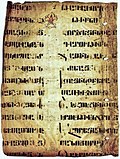| Graeco-Aryan | |
|---|---|
| Graeco-Armeno-Aryan | |
| (proposed) | |
| Geographic distribution | Southern Europe, South, Central, West Asia and the Caucasus |
| Linguistic classification | Indo-European
|
| Proto-language | Proto-Graeco-Aryan |
| Subdivisions | |
| Language codes | |
| Part of a series on |
| Indo-European topics |
|---|
 |
|
|
| Hypothetical Indo-European phylogenetic clades |
|---|
| Balkan |
| Other |
Graeco-Aryan, or Graeco-Armeno-Aryan, is a hypothetical clade within the Indo-European family that would be the ancestor of Hellenic, Armenian, and the Indo-Iranian languages, which spans Southern Europe, Armenian highlands and Southern Asian regions of Eurasia.
The Graeco-Armeno-Aryan group supposedly branched off from the parent Indo-European stem by the mid-3rd millennium BC.
Relation to the possible homeland
[edit]In the context of the Kurgan hypothesis, Graeco-Aryan is also known as "Late Proto-Indo-European" or "Late Indo-European" to suggest that Graeco-Aryan forms a dialect group, which corresponds to the latest stage of linguistic unity in the Indo-European homeland in the early part of the 3rd millennium BC. By 2500 BC, Proto-Greek and Proto-Indo-Iranian had separated and moved respectively westward and eastward from the Pontic Steppe.[1]
If Graeco-Aryan is a valid group, Grassmann's law may have a common origin in Greek and Sanskrit. However, Grassmann's law in Greek postdates certain sound changes that happened only in Greek, not Sanskrit, which suggests that it could not have been inherited directly from a common Graeco-Aryan stage. Rather, it is more likely that an areal feature spread across a then-contiguous Graeco-Aryan–speaking area. That would have occurred after early stages of Proto-Greek and Proto-Indo-Iranian had developed into separate dialects but before they ceased to be in geographic contact.[citation needed]
History of research and related proposals
[edit]Evidence for the existence of a Graeco-Aryan subclade was given by Wolfram Euler's 1979 examination on shared features in Greek and Sanskrit nominal inflection.[2] Graeco-Aryan is invoked in particular in studies of comparative mythology such as Martin Litchfield West (1999)[3] and Calvert Watkins (2001).[4]
Tamaz V. Gamkrelidze and Vyacheslav V. Ivanov included Armenian in Graeco-Aryan and argued for a primary split of Graeco-Aryan into a Greek branch with Greek as its only member, and an Armenian-Aryan branch that comprises Armenian and Indo-Iranian.[5][6][7]
Graeco-Aryan has comparatively wide support among Indo-Europeanists who support the Armenian hypothesis, which asserts that the homeland of the Indo-European language family was in the Armenian Highlands.[8][9][10]
A related proposal, Graeco-Armenian, assumes a special relation between Greek and Armenian to the exclusion of other Indo-European branches and has been popular among experts since the beginning of the 20th century,[11] although it has not gained generally acceptance, and its validity has been questioned.[12][13]
References
[edit]- ^ Martin Litchfield West, Indo-European poetry and myth (2007), p. 7.
- ^ Wolfram Euler: Indoiranisch-griechische Gemeinsamkeiten der Nominalbildung und deren indogermanische Grundlagen [= Aryan-Greek Communities in Nominal Morphology and their Indoeuropean Origins]. Innsbruck, 1979 (in German).
- ^ Litchfield West, Martin (1999). "The Invention of Homer". Classical Quarterly. 49 (364).
- ^ Calvert Watkins (2001), How to Kill a Dragon, Oxford University Press, ISBN 978-0-19-514413-0.
- ^ Handbook of Formal Languages (1997), p. 6.
- ^ Gamkrelidze, Thomas V.; Ivanov, V. V. (1990). "The Early History of Indo-European Languages". Scientific American. 262 (3): 110–117. Bibcode:1990SciAm.262c.110G. doi:10.1038/scientificamerican0390-110. JSTOR 24996796.
- ^ Gamkrelidze, Thomas V.; Ivanov, V. V. (1995). Indo-European and the Indo-Europeans: A Reconstruction and Historical Analysis of a Proto-Language and Proto-Culture. Berlin, Boston: De Gruyter Mouton. p. 323. doi:10.1515/9783110815030. ISBN 978-3-11-014728-5.
- ^ Renfrew, A. C., 1987, Archaeology and Language: The Puzzle of Indo-European Origins, London: Pimlico. ISBN 0-7126-6612-5; T. V. Gamkrelidze and V. V. Ivanov, The Early History of Indo-European Languages, Scientific American, March 1990; Renfrew, Colin (2003). "Time Depth, Convergence Theory, and Innovation in Proto-Indo-European". Languages in Prehistoric Europe. Winter. ISBN 3-8253-1449-9.
- ^ A. Bammesberger in The Cambridge History of the English Language, 1992, ISBN 978-0-521-26474-7, p. 32: the model "still remains the background of much creative work in Indo-European reconstruction" even though it is "by no means uniformly accepted by all scholars."
- ^ Mallory, James P. (1997). "Kuro-Araxes Culture". Encyclopedia of Indo-European Culture. Fitzroy Dearborn: 341–42.
- ^ Gray, Russell D.; Atkinson, Quentin D. (27 November 2003). "Language-tree divergence times support the Anatolian theory of Indo-European origin" (PDF). Nature. 426 (6965): 435–439. Bibcode:2003Natur.426..435G. doi:10.1038/nature02029. PMID 14647380. S2CID 42340. Archived from the original (PDF) on 26 March 2009.
- ^ Kim, Ronald (2018). "Greco-Armenian: The persistence of a myth". Indogermanische Forschungen. The University of British Columbia Library. doi:10.1515/if-2018-0009. S2CID 231923312. Retrieved 9 June 2019.
- ^ James Clackson (1995). The Linguistic Relationship Between Armenian and Greek. Publications of the Philological Society.
Further reading
[edit]- Martirosyan, Hrach. "The place of Armenian in the Indo-European language family: the relationship with Greek and Indo-Iranian". In: Journal of Language Relationship 10, no. 1 (2013): 85–138. https://doi.org/10.31826/jlr-2013-100107
